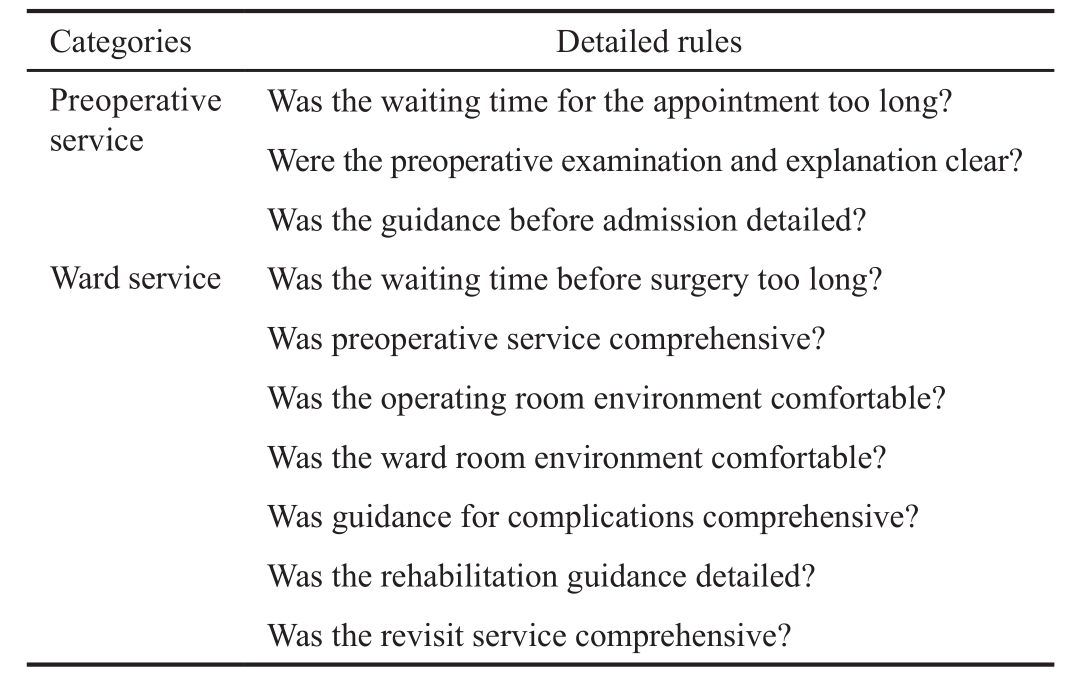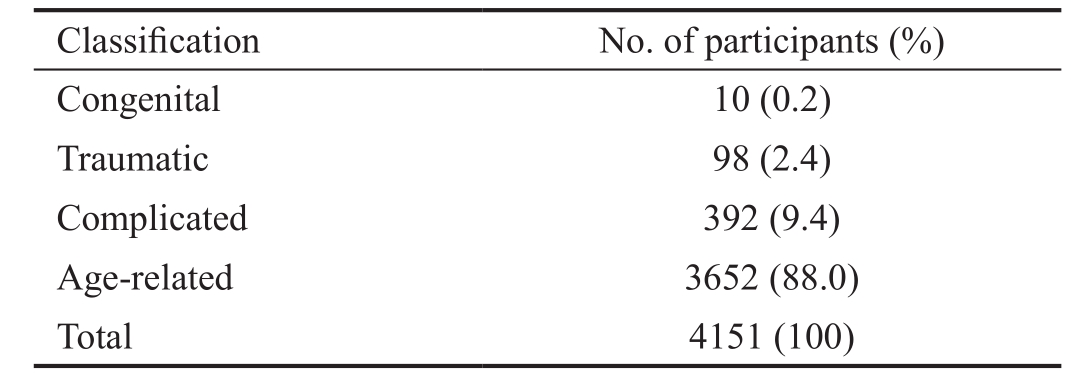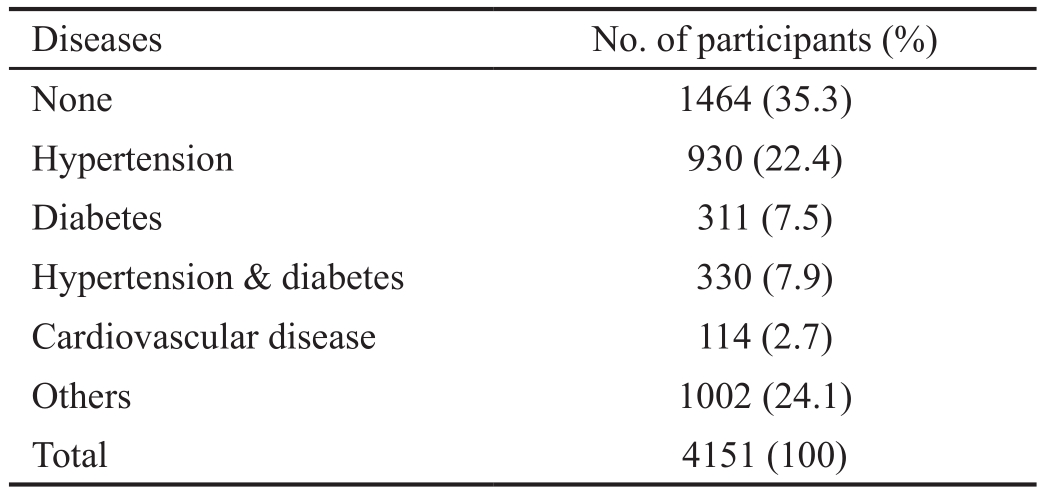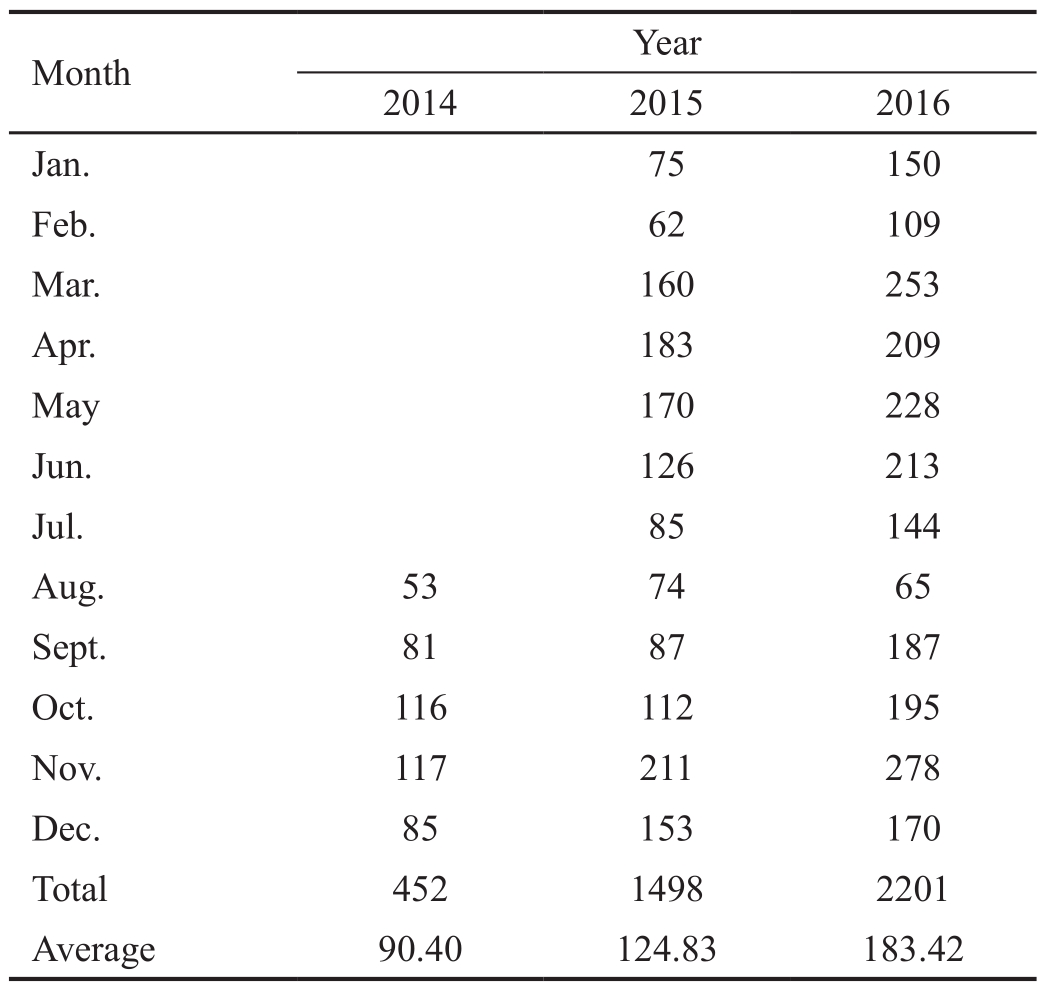Table 1 Day surgery evaluation questionnaire

?
D ay-case surgery is defined as surgery with “admission and discharge on the same day as the surgery, with daycase surgery as the intended management” and its frequency of being performed is rapidly increasing worldwide[1]. The advantages of day surgery include a shorter stay in the hospital,lower costs, earlier mobilization, lower initial postoperative pain, and lower risk of postoperative infections compared to inpatient surgery[1]. Cataract surgery is the most common optional surgical procedure worldwide, with its characteristics of being short and frequently performed making it suitable for day surgery. In developed countries, day surgery for cataract extraction may not only be cheaper, but also just as effective,as cataract extractions with hospitalization and overnight stay[2].
China has the world's largest population at over 1.406 billion people, accounting for nearly 20% of the Earth's inhabitants[3].Cataracts are the leading cause of blindness in China and the second-leading cause of vision loss burden[4]. Over the past ten years, China has made significant progress in blindness prevention and treatment. In 2005, only 57.2 million people received cataract extraction, with a rate of 440 cases per million people per year. In 2014, 1.9 million people underwent cataract extraction at a rate of 1400 cases per million people per year[5]. Relative to China's huge population, there remain many difficulties to improving the frequency of cataract operations. Therefore, it's essential to optimize day-case cataract surgery to decrease expense and increase efficiency.
The Ophthalmology of the Fifirst Affiliated Hospital of Nanjing Medical University began performing day-case cataract surgeries on August 1, 2014. This retrospective study was performed to evaluate the security and quality of day-case cataract surgery based on patient clinical data and to assess future development of this methodology.
Ethical Approval This study was performed in accordance with the Declaration of Helsinki and was approved by the Ethics Committee of the Fifirst Affiliated Hospital with Nanjing Medical University, Nanjing, China. Due to the retrospective nature of the study, informed consent was waived. The ethics review number is 2018-SR-050.
In our study, all patients meeting the inclusion criteria were enrolled consecutively into the study. The general information collected from each patient included age,diagnosis, concomitant diseases and admission time. Data on preoperative best-corrected visual acuity (BCVA) and intraocular pressure were collected from medical records during hospitalization. All patients were operated on under topical anesthesia. Data on intraoperative complications was collected from the patient operation notes. All patients received ophthalmic examinations, including BCVA, slit-lamp and intraocular pressure examinations at 1d, 1wk, and 1mo postsurgery, and the associated data were collected from outpatient medical records. The BCVAs were determined based on the International Standard Visual Acuity Chart.
Data on unplanned re-admissions to the hospital was collected by telephone follow-up 2mo post-surgery. Unplanned readmission to the hospital refers to another admission related to the surgery within 30d of discharge. The evaluation of nursing satisfaction was carried out using a self-made questionnaire designed according to the tertiary hospital satisfaction evaluation criteria developed by the Ministry of Health[6].Patients filled out the questionnaire and submitted it when they left the hospital. Ten items were included in the patient satisfaction scale on preoperative and ward service (Table 1).The score for each item was divided into three grades: very satisfactory, generally satisfactory, and unsatisfactory with corresponding scores of 3, 2, and 1, respectively. The total score was acquired by converting these to 100. A score of >80 was very satisfactory (a), 60-80 was generally satisfactory (b),and <60 was unsatisfactory (c). Satisfaction rate was calculated using the equation: satisfaction rate =(a+b)/(a+b+c)×100%[7].
Table 1 Day surgery evaluation questionnaire

?
Table 2 Cataract classi fication

?
Table 3 Age distribution

?
General Information A total of 4151 patients received daycase cataract surgery by phacoemulsification combined with posterior chamber intraocular lens implantation between August 1, 2014 and December 31, 2016 according to the Hospital Information System (HIS) database of this hospital.Of these patients, 1724 were male and 2427 were female and their cataracts were diagnosed as congenital, traumatic,complicated, or age-related with age-related being the most frequently occurring (Table 2). Patient age ranged from 18 to 101 years old with the majority of patients being between 60 and 80 years old, which corresponded with the cataract classi fication results (Table 3). There were 2687 patients with systemic diseases, of which hypertension accounted for the largest proportion (Table 4). Over the three years covered by this study, the number of people choosing day surgery increased each year, where the average number of patients permonth was 90.4, 124.83, and 183.42 in 2014, 2015, and 2016,respectively (Table 5).
Table 4 Concomitant diseases

 None 1464 (35.3)Hypertension 930 (22.4)Diabetes 311 (7.5)Hypertension & diabetes 330 (7.9)Cardiovascular disease 114 (2.7)Others 1002 (24.1)Total 4151 (100)
None 1464 (35.3)Hypertension 930 (22.4)Diabetes 311 (7.5)Hypertension & diabetes 330 (7.9)Cardiovascular disease 114 (2.7)Others 1002 (24.1)Total 4151 (100)
Table 5 Number of patients hospitalized

?
Clinical Effects The average preoperative BCVA was 0.102±0.057 and the average BCVAs at 1d, 1wk, and 1mo post-surgery were 0.453±0.264, 0.657±0.285, and 0.734±0.244, respectively. The number of patients with a BCVA <0.1 at 1d, 1wk, and 1mo post-surgery were 469, 86,and 2, respectively. A total of 99.64% (4136/4151) of patients had vision improvement post-surgery.
Intraoperative and Postoperative Complications Posterior capsule rupture (PCR) was one of the most common intraoperative complications, where it was noted in 171 cases and had an incidence rate of 4.12%. The rate of iris or ciliary body injury and suprachoroidal hemorrhage were respectively 0.79% (33/4151) and 0.048% (2/4151). Cornea edema and intraocular hypertension were the two main postoperative complications, which occurred in 182 and 323 cases with incidences of 4.38% and 7.78%, respectively, the fifirst day after surgery. The average intraocular tension at 1d, 1wk, and 1mo post-surgery were 15.88±3.87, 13.89±1.80, and 13.59±1.56 mm Hg, respectively. For other infrequent postoperative complications, the rate of IOL toxicity syndrome, retained lens cortex and hyphema were respectively 0.096% (4/4151),0.28% (12/4151) and 0.048% (2/4151). No patients had endophthalmitis.
Delayed Discharge and Unplanned Re-admission to HospitalThe delayed discharge rate refers to delayed discharge of patients due to postoperative complications or a discharge assessment that the patients did not meet the discharge criteria. Rate of unplanned re-admission to the hospital refers to patient re-admission to the hospital due to the operation within 30d. In our study, the delayed discharge rate was 0.82% (44/4151) and the unplanned re-admission to the hospital was 0 (0/4151). Under normal circumstances, patients were discharged from the hospital within 2 or 3h following a short rest in the day surgery ward after surgery. The reasons for delayed discharge were surgery-related complications and aggravated systemic conditions. The clinical manifestations the fifirst day after surgery were the most serious in the case of complications combined. At the 1mo follow-up after the surgery, all the patients had good outcomes compared to the preoperative state.
Satisfaction Survey Results All patients answered the questionnaire when they were discharged from the hospital with an effective rate of 100%. Of the 4151 patients, 2118 patients had very satisfactory, 1677 patients had generally satisfactory, and 356 patients had unsatisfactory experiences.The total satisfaction rate was 91.42% (3795/4151). The main reasons for patient dissatisfaction were payment, the complexity of the hospital admission's procedures, and the difficulty finding the doctor in the Outpatient Department after surgery.
Currently, day cataract surgery is the main surgical procedure in many European countries and the USA[8-9]. The advantages of day surgery are obvious: patients are discharged from the hospital within 24h, which greatly reduces the costs of treatment and nursing and accelerates the turnover of hospital beds, the latter of which leaves as many hospital beds open as possible for severe cases and helps achieve maximum utilization of beds. Although day surgery, including day cataract surgery, was implemented later in China than in other developed countries, it has undergone rapid development in recent years[10-13]. In our study, an increasing number of people chose day surgery for their cataract extraction based on propaganda from the media and hospital. A study utilizing a questionnaire survey revealed that the main reasons why most patients were willing to accept day surgery were to shorten the length of waiting and treatment time, followed by reducing medical expenses. More than 50% of patients accepted daycase cataract surgery[14]. In this hospital, the day surgery reception room was set up in the clinic and a specialized senior nurse was responsible for the surgical appointment for the patients, notifying the patients when to come to the hospital for surgery, and consulting with the patients. The day surgery procedures were as follows: 1) Patients diagnosed with cataracts were treated in the Outpatient Department.The outpatient examinations included blood and biochemical tests, the electrocardiogram, and the preoperative cataract examinations. 2) Contact information was registered, an appointment for an operation was made and then the patient waited at home and was treated with antibiotic eye drops for 3d before the surgery. 3) On the day of the surgery, the patients were admitted before 9 a.m., the preoperative preparation and preoperative talks were completed and the consent form for the operation was signed. The operation was then performed,where generally the outpatient doctor was the operating doctor.4) After the operation, the patients were observed in the ward for 2-3h and given discharge instructions. Except in special circumstances, the patients were discharged at 3 p.m. 5) On the first post operative day, the patients went to the ward for review. If there were no special circumstances, the patient underwent outpatient review after 1wk.
Medical safety refers to no patient physical or mental disorders or death during the course of hospital treatment. Conversely,all patient psychological, structural, or functional disorders,defects, or deaths caused by low-energy medical management systems, medical negligence, or improper malpractice during treatment belong in the medical unsafe categories[15]. The National Patient Safety Agency (NPSA) was established in response to patient safety, where a patient safety incident is defined by the NPSA as any unintended or unexpected incident that could have or did lead to harm to one or more patients receiving NHS-funded healthcare[16]. At present, there are no corresponding operation policies or definitions for day-case surgery in our country, which makes it difficult to guarantee quality and management. Ensuring the safety and quality of day-case surgery is critical for the staffs and managers and is the cornefirstone for the healthy development of this type of surgery. The Ophthalmology of the Fifirst Affiliated Hospital of Nanjing Medical University was the first hospital implementing day cataract surgery in Jiangsu Province. Initially when implementing day-case surgeries in this hospital, a complete set of day surgical procedure standards was established to ensure safety and quality[7]. The admission standards included:1) Patients are in stable conditions without serious systemic lesions and can cooperate with the surgery under local anesthesia.2) Blood pressure and glucose are in the normal ranges of patient with hypertension (blood pressure <140/85 mm Hg) or diabetes(fasting plasma glucose <7 mmol/L). 3) Patients regularly taking oral aspirin have to stop for at least 5d. All tests should be performed 1 to 3d prior to surgery and should be reviewed for more than 7d[17]. Patients should apply antibiotic eye drops locally for the 3d before surgery. These standardized perioperative management measures can effectively reduce the incision infection rate and ensure patient recovery[18]. In our study, senile people were the largest part of the patient population, of which as many as 47 were older than 90 years old. The prevalence of chronic diseases increases with age[19].The coexistence of various chronic diseases among the elderly is a very serious issue in China. In 2010, 74.2% of elderly residents aged 60 years and older suffered from at least one common chronic disease, including hypertension, diabetes,chronic obstructive pulmonary disease, asthma, and malignant tumors[20]. According to the newest guidelines, patients with stable chronic medical conditions are no longer automatically precluded from day surgery, as long as their condition is stable and can be safely managed at home during the perioperative period[1].
The indicators set by the International Association for Ambulatory Surgery (IAAS) for safety and quality monitoring include[21]: unplanned delayed discharge rate, unplanned reoperation rate, unplanned hospitalization rate again within 30d, postoperative mortality within 30d, and patient satisfaction. In our study, the monitoring indicators used in this hospital were found to be significantly better than those set by the IAAS, which may be related to the following factors: 1) With the rapid advancement of surgical techniques,cataract phacoemulsification surgery has become one of the most efficient minimally invasive operations with rapid visual outcomes and the lowest rate of complications among patients.The rates of intraoperative and postoperative complications summarized by a review were: PCR 0.5%-5.2%, iris or ciliary body injury 0.6%-1.2%, suprachoroidal hemorrhage 0-0.4%,cornea edema 0.1%-5.4%, and intraocular hypertension 0.3%-18.1%, IOL toxicity syndrome 0.1%-2.1%, retained lens cortex 0.5%-1.7%, hyphema 0.02%-0.1%, and endophthalmitis 0.006%-0.04%[22], which is consistent with the results of this study. 2) All patients were operated on under topical anesthesia,so complications due to general anesthesia did not occur. 3)Preoperative patient education and postoperative follow-up contributed to safety. The day surgery publicity manual was handed out to the patient during the appointment in the clinic to increase patient undefirstanding of the day surgery procedure.After admission, a broadcast of the matters requiring attention was played, increasing patient undefirstanding of the meaning of surgery and perioperative considerations, thus reducing patient fear and anxiety, complications, and length of hospital stay,and promoting rapid recovery after surgery[23]. A postoperative follow-up schedule of 1d, 1wk, and 1mo was implemented to ensure postoperative recovery.
“Patient satisfaction” is the highest evaluation for hospitals and is also a criterion and indicator for improving the quality of medical service[24]. In September 1997, general hospital accreditation criteria was issued by the Ministry of Health,which required the hospital to carry out a satisfaction survey and stipulated that the satisfaction rate should not be less than 85%[25]. In this study, the results were encouraging, which could increase public praise and lead to better development of day-case cataract surgery. Our study demonstrated day-case cataract surgery is a safe and effective operation according to the standardized operation management and establishment of measures to guarantee medical quality and safety. Therefore,day-case cataract surgery should be promoted country-wide due to its advantages, such as shorter length of stay and lower cost.
Authors' contributions:Zhuang M, Yuan ST and Fan W designed the research. Zhuang M and Xie P performed all experiments and analyzed the data. Zhuang M and Zhao C prepared the manuscript. Liu QH and Fan W interpreted and edited the manuscript. All authors discussed the results and commented on the manuscript.
Conflicts of Interest: Zhuang M, None; Fan W, None; Xie P,None; Yuan ST, None; Liu QH, None; Zhao C, None.
1 Anderson T, Walls M, Canelo R. Day case surgery guidelines. Surgery(Oxford) 2017;35(2):85-91.
2 Lawrence D, Fedorowicz Z, van Zuuren EJ. Day care versus inpatient surgery for age-related cataract. Cochrane Database Syst Rev 2015;2(11):CD004242.
3 Wang B, Congdon N, Bourne R, Li Y, Kai C, Zhao A, Yusufu M, Dong W, Zhou M, Wang N. Burden of vision loss associated with eye disease in China 1990-2020: findings from the Global Burden of Disease Study 2015. Br J Ophthalmol 2018;102(2):220-224.
4 Wong TY, Zheng Y, Jonas JB, Flaxman SR, Keeffe J, Leasher J, Naidoo K, Pesudovs K, Price H, White RA, Resnikoff S, Taylor HR, Bourne RR; Vision Loss Expert Group of the Global Burden of Disease Study.Prevalence and causes of vision loss in East Asia: 1990-2010. Br J Ophthalmol 2014;98(5):599-604.
5 Zhao JL. Change to “prevention of the avoidable blindness and visual impairment” from “prevention of blindness”. Zhonghua Yan Ke Za Zhi 2015;51(7):481-483.
6 Ji J. Patient satisfaction survey is an important part of medical quality evaluation. Chin J Hosp Admin 2004;20(1):49-50.
7 Cao J. Study on application of day-surgery mode in ophthalmology.Nursing of Integrated Tradition Chinese and Western Medicine 2015;1(2):115-116.
8 Mavrikakis I, Georgiou T, Paul B, Liu SC. Cataract surgery by appointment-a pilot study. BMC Ophthalmology 2006;6(1):18.
9 Mojon-Azzi SM, Mojon DS. The rate of outpatient cataract surgery in ten European countries: an analysis using data from the SHARE survey.Graefes Arch Clin Exp Ophthalmol 2007;245(7):1041-1044.
10 Li H. The application of the concept of day operation in cataract surgery. Journal of Nongken Medicine 2008;30(2):133-134.
11 Wei J, Liang Y, Wu Y, Chen M. Application of clinical pathway with day-care unit mode among patients with cataract. Chinese Health Quality Management 2016;23(4):55-57.
12 Cao W, Zhang S, Liu J, Dong H, Guo C. Observation of clinical application of cataract day operation. Chinese Remedies & Clinics 2015;15(1):108-110.
13 Lin J, Fang X, Wu S. The management pattern carried out in a cataract surgery day ward. Eye Sci 2013;28(2):79-83.
14 Sun L, Zhang Y. Study on awareness and acceptence of ophthalmological day surgery to patients. Chinese Remedies & Clinics 2017;17(2):193-195.
15 Liang MH. Safety target manual for hospital patients. Science and Technology Literature Press 2013.
16 Kelly SP, Astbury NJ. Patient safety in cataract surgery. Eye (Lond)2006;20(3):275-282.
17 Benarrochgampel J, Riall TS. What laboratory tests are required for ambulatory surgery? Adv Surg 2013;47(1):81-98.
18 Bradley S. Infection prevention practices in ambulatory surgery centers. Am J Nurs 2014;114(7):64-67.
19 Shi X, Zeng Y. Strengthen the research on aging health and actively respond to the aging population. Chin J Prev Med 2010;44(2):94-96.
20 Cui J, Mao F, Wang Z. Analysis of the coexistence of various chronic diseases among elderly residents in China. Chin J Public Health 2016;32(1):66-69.
21 Jackson I, Eshuis J, Outryve LV, Mohamed G, Castoro C, Lemos P.Ambulatory Surgery Handbook., 2nd Edition. International Association for Ambulatory Surgery (IAAS) 2014.
22 Liu YC, Wilkins M, Kim T, Malyugin B, Mehta JS. Cataracts. The Lancet 2017;390(10094):600-612.
23 Younis J, Salerno G, Fanto D, Hadjipavlou M, Chellar D, Trickett JP. Focused preoperative patient stoma education, prior to ileostomy formation after anterior resection, contributes to a reduction in delayed discharge within the enhanced recovery programme. Int J Colorectal Dis 2012;27(1):43-47.
24 Kunze B, Drasseck T, Kluba T. Posterior and transforaminal lumbar interbody fusion (PLIF/TLIF) for the treatment of localised segment degeneration of lumbar spine. Z Orthop Unfall 2011;149(3):312-316.
25 Guo Q, Zhang L, Fan S, Xiao H, Xu P. Application of the customer theory in the continuous quality improvement(CQI) of medical services.Chin J Hosp Admin 2000;16(9):556-556.